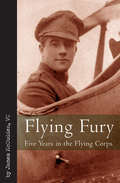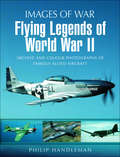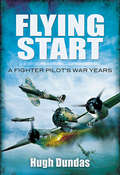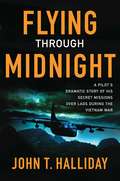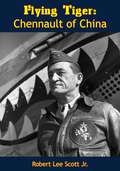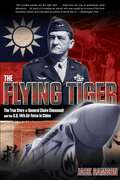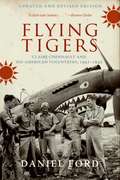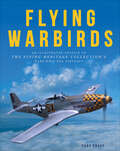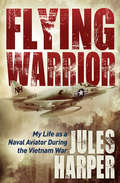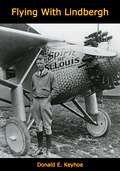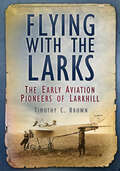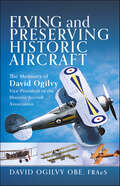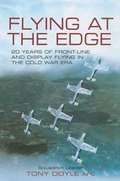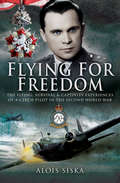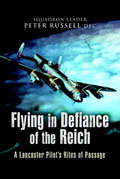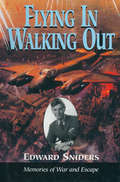- Table View
- List View
Flying Fortress: The Illustrated Biography of the B-17s and the Men Who Flew Them
by Edward JablonskiRenowned throughout the world for its strength and destructiveness, the Flying Fortress was one of the greatest fighting airplanes of all time. In this comprehensively documented biography, Edward Jablonski tells the story of the Flying Fortress Boeing B-17, America’s legendary long-range bomber. From the B-17's near death in infancy to the emergence of its successor, the Superfortress, Flying Fortress captures the exhilarating career of the B-17 with thrilling accounts of the exploits of these planes and their pilots. In this unforgettable history, Jablonski details the Fortress’s role in the strategic and tactical issues of air war, and chronicles the B-17’s roles in famous raids including Regensburg, Marienburg, Munster, Schweinfurt, Dresden, and Berlin, along with its part in great battles, such as D-Day. Masterfully written, Flying Fortress is a classic in aviation literature with over 400 illustrations (many unpublished action photos) in addition to a section on the design of the Flying Fortress, which includes a number of detailed cutaway drawings. Approximately 60 pages from the Flying Fortress’s Piloting Manual are also featured herein. Find out why the Flying Fortress ultimately redefined the concept of war.
Flying Forwards, Facing Backwards: Captivating Tales from a Vulcan and Nimrod Air Electronics Operator
by Jim WallsSince he was a child in the 1950s watching Vampires and Meteors operating from RAF Turnhouse, Jim Walls wanted to fly aircraft, he just never envisaged that his flying career would be spent in the back seat as opposed to the front. Jim guides readers through his 40-year RAF career that started as a Boy Entrant at RAF Cosford, then as an air radar tradesman, before specializing as an air electronics operator (AEOp) in the Nimrod MR1, and later as an air electronics officer (AEO) who flew in Nimrod R1s and Vulcan B2s. With detailed insight into the world of radar, electronic countermeasures, and signals intelligence, Jim highlights the role they played in warfare for numerous operations during the Cold War as well as the Falklands campaign, First Gulf War, and Bosnian War. He also recalls the peacetime role of the Nimrod and Vulcan with stories from his time on 51, 120, and 617 Squadrons. As well as focusing on his career, Jim gives his viewpoint on matters such as Operation Black Buck and the reduced war-fighting capability of the Vulcan as it neared retirement. This fascinating book showcases the vital role that AEOs held and the importance of radar and electronic warfare in the fight against enemy forces. It is also a tribute to the much-loved Cold War icons, the Nimrod and the Vulcan. With photography throughout, mainly from the author’s personal collection, this book will appeal to Cold War enthusiasts and fans of the iconic jets of that era.
Flying Fox: Otto Fuchs: A German Aviator’s Story, 1917–1918
by Adam M. WaitUnique personal history of the Imperial German Air Service
Flying Freestyle: An RAF Fast Jet Pilot's Story
by Jerry PookA British Royal Air Force pilot recounts his 25-year career in the cockpit during the Cold War in this military memoir. During a twenty-five-year flying career in the RAF, Jerry Pook has flown Hunter Fighter/Ground Attack aircraft in the Gulf, Harriers in West Germany, the supersonic Starfighter with the Dutch Air Force, the Harrier in Belize, Central America and the Tornado bomber at the Tri-national Tornado Training Establishment where he trained German and Italian pilots and navigators. Jerry had a long relationship with the Harrier Fighter/Ground Attack vertical take-off aircraft. This he flew in West Germany at the height of the Cold War operating from Wildenrath and off-base operations with Field Wing operations based in the fields and woods of the German countryside. Jerry saw action during the Falklands War when based on HMS Hermes and flying one of the few RAF Harriers in the Ground Attack role in support of the troops fighting ashore. He then enjoyed flying the American-built Starfighter RF 104G during a three-year exchange tour with the Dutch Air Force—he describes the Starfighter as &“beautiful to fly, smooth and sophisticated, supremely fast and powerful—if you took liberties with it you knew it would kill you in an instant.&” After three years with No 1 (Fighter) Squadron and again flying the Harrier, he moved to the then new Tornado, flying in its bomber role. This he continued to fly operationally and in the instructional role for thirteen years until grounded from military flying for medical reasons.
Flying Fury: Five Years in the Royal Flying Corps (Vintage Aviation Library)
by James B. McCuddenThe day-to-day insights of a brilliantly daring World War I ace that only ends with his death at the age of 23 . . . James McCudden was an outstanding British fighter ace of World War I, whose daring exploits earned him a tremendous reputation and, ultimately, an untimely end. Here, in this unique and gripping firsthand account, he brings to life some of aviation history&’s most dramatic episodes in a memoir completed at the age of twenty-three, just days before his tragic death. During his time in France with the Royal Flying Corps from 1914 to 1918, McCudden rose from mechanic to pilot and flight commander. Following his first kill in September 1916, McCudden shot down a total of fifty-seven enemy planes, including a remarkable three in a single minute in January 1918. A dashing patrol leader, he combined courage, loyalty, and judgment, studying the habits and psychology of enemy pilots and stalking them with patience and tenacity. Written with modesty and frankness, yet acutely perceptive, Flying Fury is both a valuable insight into the world of early aviation and a powerful account of courage and survival above the mud and trenches of Flanders. Fighter ace James McCudden died in July 1918, after engine failure caused his plane to crash just four months before the end of World War I. His success as one of Britain&’s deadliest pilots earned him the Victoria Cross.
Flying Is My Life [Illustrated Edition]
by Hanna Reitsch Lawrence Roy WilsonIncludes the Aerial Warfare In Europe During World War II illustrations pack with over 200 maps, plans, and photos.Hanna Reitsch is unusual in being a feminine woman who was yet the equal of men in a dangerous male profession -- test-piloting new military aircraft. Her love of flying from childhood on, along with her superior intelligence, determination, and ability to withstand tremendous stresses, gave her the edge that allowed her to rise to the top of the aviation world.Hanna Reitsch offered her gifts to the German nation in the same way that Adolf Hitler and many others did -- with a complete giving of herself and her abilities, holding nothing back. Although she lived to 1979, she never renounced her participation with the National Socialist government or criticized Hitler, even under pressure to do so. Hanna's life story is an amazing one that sounds almost unbelievable in its drama and acts of heroism. She never married or had children; instead she occupied herself with the two burning loves of her life -- flying and the salvation of her beloved Fatherland in its time of need.
Flying Legends of World War II: Archive and Colour Photos of Famous Allied Aircraft (Images of War)
by Philip HandlemanMore than thirty Allied Forces' WWII aircraft types are illustrated in many rare and previously unpublished black and white and color photographs. Each type is described giving vital data on development history, combat record, famous pilots and significant air battles. Performance, range and weapon loads are also included. The unique color photographs are from the collection of the late William B. Slate, an aviation photographer who strove to capture the thrilling perspective that can only come from close-up, in-flight vantage points from an aircraft flying in formation.
Flying Scot: An Airman’s Story
by Alastair Mackie"This is the memoir of a 26 year career in the RAF, told with humor and modesty that belies the danger of flying over 47 different types of military aircraft in war and peace. Alastair Mackie began his operational career flying Wellington bombers over the North African desert war until converting to the B-24 Liberator. He watched the famous opening barrage at the opening of El Alamein from the air and became involved in supplying the besieged island of Malta together with hunting German ships in the Mediterranean. He was then posted to Northern Ireland converting to the DC-3. He flew during D-Day, dropping parachute troops into German held territory and continued these operations until the wars end when he was part of the operation to return British troops and released POWs to the UK. He was then posted to a long-range DC-3 squadron and flew to all points East.After the war he was posted to The Central Flying School teaching future flying instructors in a variety of aircraft from Tiger Moths to Lancasters. After a tour in the Far East where he flew his own personal Spitfire, he returned to the UK to convert to the jet aircraft then coming into service. After a spell desk bound on the Cabinet Office Joint Intelligence Committee, which he disliked, he was appointed Station Commander at Colerne which operated the Hastings transport aircraft. Alastair was then appointed wing commander in charge of flying at RAF Waddington. The job also gave him the charge of two resident Canberra bomber squadrons, Nos. 37 and 38. With them he was able to get plenty of flying in an aircraft he loved. After retiring from the RAF he commenced a career in Law and in his later years he has become a firm opponent of Britains nuclear deterrent, having seen its preparation with the Vulcan Force until the Royal Navy assumed the role it now has. "
Flying Start: A Fighter Pilot's War Years
by Hugh DundasThis is the autobiography of Group Captain Sir Hugh Dundas CBE, DSO, DFC, who was one of the most distinguished fighter pilots of World War II. He writes of his wartime experiences, and particularly of his period as Squadron Leader and Wing Commander and his involvement in the Battle of Britain.
Flying Through Midnight: A Pilot's Dramatic Story of His Secret Missions Over Laos During the Vietnam War
by John T. HallidayRiveting, novelistic, and startlingly candid, John T. Halliday's combat memoir begins in 1970, when Halliday has just landed in the middle of the Vietnam War, primed to begin his assignment with the 606th Special Operations Squadron. But there's a catch: He's stationed in a kind of no-man's-land. No one on his base flies with ID, patches, or rank. Even as Richard Nixon firmly denies reporters' charges that the United States has forces in Laos, Halliday realizes that from his base in Thailand, he will be flying top-secret, black-ops night missions over the Laotian Ho Chi Minh Trail. A naive yet thoughtful twenty-four-year-old, Halliday was utterly unprepared for the horrors of war. On his first mission, Halliday's C-123 aircraft dodges more than a thousand antiaircraft shells, and that is just the beginning. Nothing is as he expected -- not the operations, not the way his shell-shocked fellow pilots look and act, and certainly not the squadron's daredevil, seat-of-one's-pants approach to piloting. But before long, Halliday has become one of those seasoned and shell-shocked pilots, and finds himself in a desperate search for a way to elude certain death. Using frank, true-to-life dialogue, potent imagery, and classic 1970s song lyrics, Halliday deftly describes the fraught Laotian skies and re-creates his struggle to navigate the frustrating Air Force bureaucracy, the deprivations of a remote base far from home and his young wife, and his fight to preserve his sanity. The resulting nonfiction narrative vividly captures not only the intricate, distorted culture of war but also the essence of the Vietnam veteran's experience of this troubled era. A powerhouse fusion of pathos and humor, brutal realism and intimate reflection, Flying Through Midnight is a landmark contribution to war literature, revealing previously top-secret intelligence on the 606th's night missions. Fast-paced, thrilling, and bitingly intelligent, Halliday illuminates it all: the heart-pounding air battles, the close friendships, the crippling fear, and the astonishing final escape that made the telling of it possible.
Flying Through Midnight: A Pilot's Dramatic Story of His Secret Missions over Laos During the Vietnam War
by John T. HallidayRiveting, novelistic, and startlingly candid, John T. Halliday's combat memoir begins in 1970, when Halliday has just landed in the middle of the Vietnam War, primed to begin his assignment with the 606th Special Operations Squadron. But there's a catch: He's stationed in a kind of no-man's-land. No one on his base flies with ID, patches, or rank. Even as Richard Nixon firmly denies reporters' charges that the United States has forces in Laos, Halliday realizes that from his base in Thailand, he will be flying top-secret, black-ops night missions over the Laotian Ho Chi Minh Trail. A naive yet thoughtful twenty-four-year-old, Halliday was utterly unprepared for the horrors of war. On his first mission, Halliday's C-123 aircraft dodges more than a thousand antiaircraft shells, and that is just the beginning. Nothing is as he expected -- not the operations, not the way his shell-shocked fellow pilots look and act, and certainly not the squadron's daredevil, seat-of-one's-pants approach to piloting. But before long, Halliday has become one of those seasoned and shell-shocked pilots, and finds himself in a desperate search for a way to elude certain death. Using frank, true-to-life dialogue, potent imagery, and classic 1970s song lyrics, Halliday deftly describes the fraught Laotian skies and re-creates his struggle to navigate the frustrating Air Force bureaucracy, the deprivations of a remote base far from home and his young wife, and his fight to preserve his sanity. The resulting nonfiction narrative vividly captures not only the intricate, distorted culture of war but also the essence of the Vietnam veteran's experience of this troubled era. A powerhouse fusion of pathos and humor, brutal realism and intimate reflection, Flying Through Midnight is a landmark contribution to war literature, revealing previously top-secret intelligence on the 606th's night missions. Fast-paced, thrilling, and bitingly intelligent, Halliday illuminates it all: the heart-pounding air battles, the close friendships, the crippling fear, and the astonishing final escape that made the telling of it possible.
Flying Tiger: Chennault of China
by Robert Lee Scott Jr.Flying Tiger: Chennault of China by Robert Lee Scott, Jr. tells the story of a rebel whose concepts as to the use of air power often clashed with the orthodox and standardized teachings of the military schools of his time.
Flying Tiger: The True Story of General Claire Chennault and the U.S. 14th Air Force in China
by Jack SamsonThe Flying Tigers and the U.S. Fourteenth will be the subject of a huge upcoming film from IMAX and director John Woo. The film is scheduled to start shooting in spring 2011 with no firm release date stated yet. The role of Chenault in the film is likely to be the role of a lifetime for a huge star. When a sickly, half-deaf, forty-seven-year-old retired U.S. Army Air Corps Captain went to China in 1937 to survey Chiang Kai-shek’s Chinese Air Force, little did the world know this would be the man to stem the Japanese tide in the Far East. Almost every military expert predicted his handful of pilots of the American Volunteer Group would not last three weeks. Yet in seven months in 1942, the AVG, fighting a rear-guard action over Burma, China, Thailand, and French Indonesia, destroyed a confirmed 199 planes, with another 153 “probables” as well. They did this losing only four pilots and twelve P-40s in air combat and sixty-one on the ground.In this definitive biography of General Claire Chennault, veteran reporter Jack Samson offers a rare and fascinating inside look at this legendary man behind the Flying Tigers.Unlike Eisenhower and MacArthur, Chennault was no saintly military leader. He was a chain-smoking, bourbon-drinking, womanizing man. He was the kind of leader his men knew could and did fly better than they--in any kind of plane. But first and last, he was a fighter--a tough, single-minded warrior who was never confused by who the enemy was in Asia, regardless of what the State Department thought.Following Chennault from this command of the Fourteenth U.S. Army Air Force during World War II to the part of his life that is not well known--the intriguing postwar years in China and Formosa, where his Civilian Air Transport (CAT) became the scourge of the Red Chinese--The Flying Tiger is an extraordinary portrait of one of America’s great military commanders.
Flying Tigers
by Daniel FordDuring World War II, in the skies over Rangoon, Burma, a handful of American pilots met and bloodied the "Imperial Wild Eagles" of Japan and in turn won immortality as the Flying Tigers. One of America's most famous combat forces, the Tigers were recruited to defend beleaguered China for $600 a month and a bounty of $500 for each Japanese plane they shot down-fantastic money in an era when a Manhattan hotel room cost three dollars a night. To bring his prize-winning history of the American Volunteer Group up to date, Daniel Ford has completely rewritten his 1991 text, drawing on the most recent U.S., British, and Japanese scholarship. New material from AVG veterans-including Erik Shilling and Tex Hill-help fill out the story, along with newfound recollections from Japanese and New Zealand airmen. Ford also takes up the rumors that Royal Air Force pilots "sold" combat victories to the Flying Tigers in order to share in the bounties paid by the Chinese government. "Admirable," wrote Chennault biographer Martha Byrd of Ford's original text. "A readable book based on sound sources. Expect some surprises." Even more could that be said of this new and more complete edition.
Flying Warbirds: An Illustrated Profile of the Flying Heritage Collection's Rare WWII-Era Aircraft
by Cory GraffGet a comprehensive look at how World War II was fought from the air.Do you want to get an up-close look at some of the rarest airplanes in the world? Are you curious about combat aircraft from World War II? In deluxe hard-back volumes, Flying Warbirds brings U.S., British, German, Russian and Japanese fighting planes from the 1930s and 1940s together, complete with detailed photographs to delight every aeronautics connoisseur.The airplanes at the Flying Heritage Collection were created at a time when aeronautical discovery had evolved to aviation mastery. Finely crafted by distinguished design bureaus with the leading technologies of the 1930s and 1940s, the main emphasis of the collection includes combat aircraft from World War II.In 1998, Paul G. Allen began acquiring and preserving these iconic warriors and workhorses, many of which are the last of their kind. Allen's passion for aviation and history, and his awareness of the increasing rarity of original WWII aircraft, motivated him to restore these artifacts to the highest standard of authenticity.Periodically, one or more of the exhibits are temporarily absent to participate in an event, for maintenance, or for continuing restoration. Experience one of the world’s top airplane collections any time you like through Flying Warbirds.Photographs include cockpit shots, exterior museum shots, historic photographs, and breathtaking contemporary flying shots from photographers like award-winning John Dibbs. Flying Warbirds is the definitive guide to everything you want to know about this fascinating period in aeronautics and military history.
Flying Warrior: My Life as a Naval Aviator During the Vietnam War
by Jules HarperA Vietnam veteran takes you into the cockpit and shares true stories of his flying career in this compelling memoir. In this action-packed memoir, Jules Harper recounts the unique process of becoming a naval aviator, revealing his experiences as a brand new pilot in a combat squadron and, finally, a flying warrior. He survived two combat cruises aboard the aircraft carrier USS Kitty Hawk from 1966–1968, compiled 332 career carrier takeoffs and landings, and was shot at daily by enemy fire while completing 200 combat missions over Vietnam, and shares the views of the aviators who flew along with him on these missions while fighting this unpopular war. A recipient of the Distinguished Flying Cross, twenty-one Air Medals, and many other accolades, he offers readers a new understanding and appreciation of the warriors who protect not only their comrades in arms, but the defense of the nation as well.
Flying With Lindbergh
by Donald E. KeyhoeOriginally published in 1928, this is a biography of Colonel Charles Lindbergh (1902-1974), an aviation pioneer and hero of the times.Nicknamed “Slim,” “Lucky Lindy,” and “The Lone Eagle,” Charles Augustus Lindbergh (1902-1974) emerged from virtual obscurity in 1927, at the age of 25, as a U.S. Air Mail pilot to instantaneous world fame as the result of his Orteig Prize-winning solo nonstop flight from Roosevelt Field on Long Island, New York, to Le Bourget Field in Paris, France.He flew the distance of nearly 3,600 statute miles (5,800 km) in a single-seat, single-engine, purpose-built Ryan monoplane, Spirit of St. Louis and became the 19th person to make a Transatlantic flight, the first being the Transatlantic flight of Alcock and Brown from Newfoundland in 1919; however, Lindbergh’s flight was almost twice the distance. The record-setting flight took 33 1⁄2 hours and resulted in Lindbergh, a U.S. Army Air Corps Reserve officer, being awarded the nation’s highest military decoration, the Medal of Honor, for his historic exploit.Considered one of the most admired figures of his time, author Donald E. Keyhoe presents a clear picture of the life and times of this fascinating man.This work will catapult the reader into a feeling of journeying across the country with Lindbergh himself.
Flying With the Larks: The Early Aviation Pioneers of Larkhill
by Timothy C. BrownIn 1903 the Wright Brothers achieved their dream of powered flight and from then on man’s domination of the skies became a reality. The military potential of aircraft was obvious from the outset, first as a way of spying on the enemy with reconnaissance planes and balloons armed with early cameras, and then as a way of taking the battle into the skies, as planes became weapons of war. In Britain these early days of military aviation were pioneered by a group of enthusiastic civilians and military men who were based at Lark Hill, Wiltshire where the rolling plains became ideal flying grounds. Here, the first military aviation base came into existence. Flying with the Larks charts its early days and its influence on First World War aviation.
Flying and Preserving Historic Aircraft: The Memoirs of David Ogilvy OBE, Vice-President of the Historic Aircraft Association
by David Frederick OgilvyDavid Ogilvy has spent more than a full working life in aviation. As a schoolboy he was sent out with a bugle and binoculars to blow a warning if a V1 flying bomb appeared. Soon after this, he joined the Royal Air Force and served for six years as a pilot, flying types ranging from the Tiger Moth to the Mosquito and Meteor. As a civilian he spent fourteen years involved in pilot training and became Chief Instructor of the Air Schools group, with responsibility for three establishments. He was a keen display and racing pilot and competed in many events, flying several historic types. At an early age David realised the need for owners and operators of flyable pre-war machines to have a representative organization to look after their concerns and interests, so, in 1951, when 22 and still serving in the RAF, he was a co-founder of the Vintage Aeroplane Club. He was also a founding member, and now a Vice President, of the Historic Aircraft Association. In 1966 David was appointed general manager of the famous Shuttleworth Collection at Old Warden. During this time, he brought in several historic aircraft, including initiating the retrieval of a 1935 Hawker Hind from Afghanistan. He flew many of the Collection’s remarkable airplanes, organizing and participating in the displays. As well as outlining his remarkable career, the main focus of this book is on David Ogilvy's descriptions of many of the historic aircraft he helped rescue and preserve and what it was like to be at their controls. It therefore provides a unique compendium of the flying characteristics of a range of historic aircraft for one or two of which, he unashamedly admits, he is possibly the last man alive to have flown. Away from the cockpit, David has been associated with many organizations, including being a founder member of the UK Aircraft Owners and Pilots Association, serving for 45 years in the roles of editor, Executive Chairman and President. He is also President of today's Vintage Aircraft Club and is a Fellow of the Royal Aeronautical Society. David was awarded the OBE ‘for services to aviation’ in I996.
Flying at the Edge: 20 Years of Front-Line and Display Flying in the Cold War Era
by Tony DoyleA firsthand account of a twenty-year career as an RAF fighter pilot, instructor, aerobatic flyer, and squadron leader. Tony Doyle first flew in the CCF, where he completed a glider course and then a highly prized Flying Scholarship. This opened the way to joining the RAF and becoming an all-weather tactical fighter pilot flying de Havilland Vampires and Gloster Meteors. At this he excelled, and he was posted as a flying instructor and then Staff Instructor. This was the age when the Jet Provost was the standard training aircraft. In 1962, Doyle was selected to fly with the newly formed Red Pelicans aerobatic display team and honed his skills as a display pilot. He moved to RAF Valley as the new Folland Gnat was being introduced in the training role. This diminutive aircraft was somewhat of a breakthrough—and after several design problems were ironed out it proved a superb aircraft, fast and agile. The general public were eager to see this new RAF addition and Doyle became its display pilot, flying at open days throughout the UK and Europe. In 1964 he converted to the English Electric Lightning, Britain&’s one and only supersonic fighter, with a top speed in excess of Mach 2 and a ceiling of 50,000 feet. He was posted to Treble One Squadron at Wattisham in October 1964 as part of the Quick Reaction Alert force against potential Russian bomber attacks. Once again he became the Lightning&’s chosen low-level display pilot and demonstrated it at the 1965 Paris Air Show. Shortly after that, he was forced to eject over the North Cornish coast after an engine explosion caused the loss of elevator control. This fascinating account of front-line and display flying goes into considerable detail of the aerodynamic qualities, dangers, and advantages of the types flown—and recounts life-threatening incidents and successes that will educate anyone interested in flying at the very edge.
Flying for Freedom: The Allied Air Forces in the RAF 1939-45
by Alan BrownAfter the Dunkirk debacle in May 1940, Britain's primary weapon of defence was her air force. The exploits of the RAF's bomber crews and fighter pilots featured almost nightly on the radio and in the cinema newsreels; the men themselves were the objects of great admiration and respect. Yet, how many of these brave airmen were not British nationals? During the Second World War, exiled airmen from six occupied countries in Europe flew from British soil, fighting in or alongside the squadrons of the RAF; each had a burning desire to strike back at the cruel regime that had so ruthlessly crushed his homeland. At the political level, the exiled governments were keen for their country's active service arms to remain independent, but the RAF had different ideas. Many influential sections of the Air Ministry avoided making firm commitments to their allies and considered these new reinforcements to have been thrust upon them. This book explores these courageous and often undervalued men, who were caught up in a web of political argument.
Flying for Freedom: The Flying, Survival and Captivity Experiences of a Czech Pilot in the Second World War
by Alois SiskaAlois Siska was born in Czechoslovakia and learnt to fly. He escaped to the UK after the German invasion and joined the R.A.F. He describes his experiences flying Wellington bombers. In December 1943 he was shot down and he and surviving members of the crew were adrift in the North Sea for 7 days in appalling conditions. Picked up by the Germans he underwent surgery to his badly wounded legs and became a POW. He suffered at the hands of the Gestapo and was held in numerous camps including Colditz. His injuries were so extensive that he was put under the care of Archibald McIndoe. Siska chose to return to his native country to join their air force but fell foul of the Communist authorities. His persecution is described in the closing chapters. His rank was restored only in 1991 on the collapse of the Communist regime. Despite his injuries he remained active until 2003 when he died just short of his 90th birthday. He was as an active member of the Czech Ex-R.A.F. Association, the R.A.F. Benevolent Fund in his country, and the Sue Ryder Homes for which he raised considerable funds. His death was marked with a fly-past of the Czech Air Force and he was posthumously awarded the highest military decoration—The Order of the White Lion.
Flying from the Black Hole
by Robert O. HarderAir Force navigators and bombardiers have long labored under the shadow of pilots--their contributions undervalued, misunderstood, or simply unknown to the general public. This was especially the case with the non-pilot officer aircrew in the Vietnam and Cold War-era B-52 Stratofortress. Of the six people who operated the bomber, three wore navigator wings--two of those men were also bombardiers, the other an electronic warfare officer. Without the navigator-bombardiers in particular, executing the nuclear war strike plan or flying Southeast Asian conventional bombing sorties would have been impossible. This book reveals who these men were and what they did down in the "Black Hole," a story told by one of their own.
Flying in Defiance of the Reich: A Lancaster Pilot's Rites of Passage
by Peter RussellThis is the vivid memoir of a man who was twenty-one at the outbreak of World War II. Having joined the RAFVR before the war, he was mobilized in August 1939 and after training became operational on 233 Squadron Coastal Command flying Hudsons from Leuchars, Aldergrove and St Eval. After fourteen months he was rested and was tasked with training navigators for the impending enlargement of Bomber Command.In 1944 he joined 625 Squadron flying Lancasters over German targets and eventually took command of B Flight and was promoted Squadron Leader. His memories of the many raids, his crew and operational flying during this period until the end of the war are truly gripping. After the German capitulation, Peter joined Shield Force bound for the Far-east and the night bombing of Japan. However before they could become operational the atom bomb put an end to the war in that theater. His unit was redirected to relieve Hong Kong and the final chapters give a unique insight into how the Japanese garrison was replaced by British law and order. This was a purely land operation carried out by the RAF without the presence of the Army.
Flying in Walking Out: Memories of War and Escape (Soundings Ser.)
by Edward SnidersEdward Sniders'' experiences of World War Two make compelling reading. As a Mosquito pilot, he led a charmed life until his luck ran out in dramatic fashion.'




